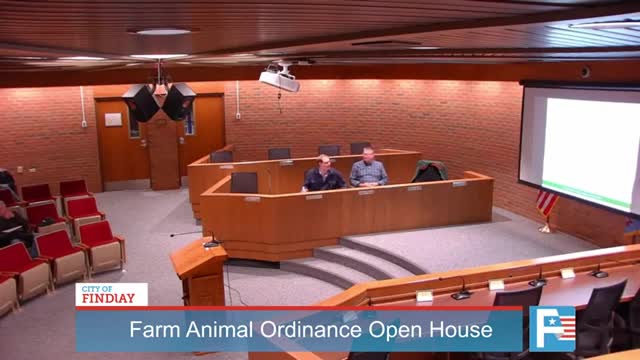Findlay officials present pared-down farm-animal ordinance, invite public feedback
November 11, 2025 | Findlay City, Hancock County , Ohio
This article was created by AI summarizing key points discussed. AI makes mistakes, so for full details and context, please refer to the video of the full meeting. Please report any errors so we can fix them. Report an error »

City planning staff presented a simplified draft farm-animal ordinance at a public forum and asked residents for feedback on definitions, lot-size thresholds and enforcement.
Matt Cardano, director of Hancock Regional Planning, said the one-page draft would be added to chapter 505.08 of the Findlay municipal code and referenced state regulation OAC 901.12. The draft permits noncommercial small animals (defined in the draft as animals under 50 pounds, such as chickens, ducks and rabbits) on any parcel, subject to existing sanitation and nuisance rules. Medium animals (50–500 pounds) would require a minimum 1-acre lot, rear-yard fencing and a shelter meeting zoning setbacks. Large animals (greater than 500 pounds) would require a minimum 3-acre lot and the same fencing/shelter setbacks, staff said.
Cardano said the ordinance also contains sanitation standards, allows on-site slaughter only for small animals for household use (not visible from neighbors or streets), and includes exemptions for youth-education programs such as 4‑H when written verification is provided. On grandfathering, staff proposed nonconforming uses remain lawful if proof of prior use is submitted within 90 days; Cardano said that protection ‘‘goes with the property’’ but that nonconformity can be lost if the use discontinues for a year.
Rob Feitner, the city law director, described enforcement as a layered process: officers or zoning staff would investigate complaints, and his office would screen officer reports before charging. ‘‘Charges are always a last‑ditch effort, when it comes through my office,’’ Feitner said, stressing prosecutorial discretion.
Cardano said staff reviewed roughly 117 other cities when drafting the ordinance and intentionally shortened an earlier seven‑page draft to a more limited, conservative one‑page version. He said the draft would be discussed at Planning & Zoning Committee on Thursday at noon and then proceed to City Council for readings.
The forum produced a mix of feedback about thresholds, enforcement and definitions. Staff emphasized that no legislation would be passed at the meeting and that the public comment would inform the committee and council process.
Matt Cardano, director of Hancock Regional Planning, said the one-page draft would be added to chapter 505.08 of the Findlay municipal code and referenced state regulation OAC 901.12. The draft permits noncommercial small animals (defined in the draft as animals under 50 pounds, such as chickens, ducks and rabbits) on any parcel, subject to existing sanitation and nuisance rules. Medium animals (50–500 pounds) would require a minimum 1-acre lot, rear-yard fencing and a shelter meeting zoning setbacks. Large animals (greater than 500 pounds) would require a minimum 3-acre lot and the same fencing/shelter setbacks, staff said.
Cardano said the ordinance also contains sanitation standards, allows on-site slaughter only for small animals for household use (not visible from neighbors or streets), and includes exemptions for youth-education programs such as 4‑H when written verification is provided. On grandfathering, staff proposed nonconforming uses remain lawful if proof of prior use is submitted within 90 days; Cardano said that protection ‘‘goes with the property’’ but that nonconformity can be lost if the use discontinues for a year.
Rob Feitner, the city law director, described enforcement as a layered process: officers or zoning staff would investigate complaints, and his office would screen officer reports before charging. ‘‘Charges are always a last‑ditch effort, when it comes through my office,’’ Feitner said, stressing prosecutorial discretion.
Cardano said staff reviewed roughly 117 other cities when drafting the ordinance and intentionally shortened an earlier seven‑page draft to a more limited, conservative one‑page version. He said the draft would be discussed at Planning & Zoning Committee on Thursday at noon and then proceed to City Council for readings.
The forum produced a mix of feedback about thresholds, enforcement and definitions. Staff emphasized that no legislation would be passed at the meeting and that the public comment would inform the committee and council process.
View full meeting
This article is based on a recent meeting—watch the full video and explore the complete transcript for deeper insights into the discussion.
View full meeting
